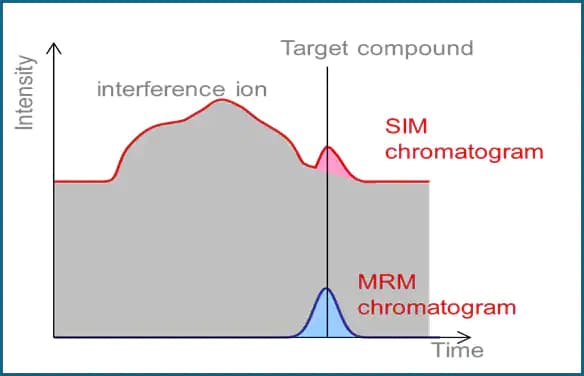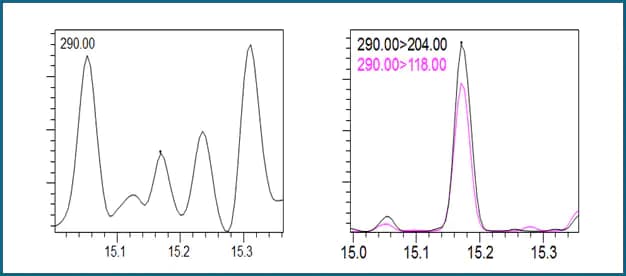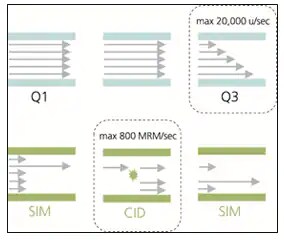Environmental Solutions
Shimadzu Gas Chromatography Tandem Mass Spectrometry
Triple quadrupole GC-MS/MS is a relatively new technology for targeted environmental analyses, due to its high level of selectivity and sensitivity. A triple quadrupole operates very similar to single quadrupole except that a collision cell and another quadrupole is added. The extra quadrupole after the collision cell selectively eliminates almost all noise. The signal from the triple quadrupole (MRM) is lower than the SIM signal, but after the collision cell and second quadrupole there is almost no noise. This elimination of noise significantly increases the signal-to-noise ratio, lowering the detection limit of MRM relative to SIM.

For an MRM transition, the compounds eluting from the column are first fragmented by the source, just as in regular single quadrupole GCMS. One of the fragments passes through the first quadrupole as a SIM ion. This SIM ion is a precursor ion. The precursor ion passes through the collision cell and is bombarded with helium collision gas at a predetermined energy to fragment it into product ions. The product ions pass through the second quadrupole as SIM ions. One product ion is called SRM and multiple product ions measured are called MRM. Using multiple ions enables one ion to be the quant ion and other ions to be qualifier ions.
The figure below shows the tremendous selectivity and noise reduction of MRM compared to SIM. The chromatogram on the left is a SIM ion at mass 290. The chromatogram on the right shows two MRM product ions after collision of the 290 ion. Note the absence of baseline, and extremely higher S/N ratio.

An advantage of the Shimadzu GCMS-TQ8040 is that you can also run your semi-volatiles in full scan mode. You can essentially turn off the first quad and the collision cell and you have equal to, or even better, sensitivity than the GCMS-QP2020. This means you can use your GCMS-TQ8040 for both EPA approved single quadrupole methods and triple quadrupole MRM methods.

Other Solutions
- Atomic Absorption
- Balances
- Energy Dispersive XRF
- Gas Chromatography
- GCMS
- Gas Chromatography Tandem Mass Spectrometry
- HPLC
- ICP/AES
- ICP/MS
- Ion Chromatography
- LCMS
- MALDI iD-Plus
- On-Line Analyzers
- Spectrophotometers
- Total Nitrogen Analyzers
- Total Organic Carbon Analyzers (TOC)
- Return to Environmental Top Page


